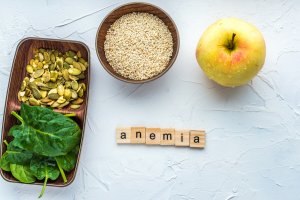Types of Anemia

Anemia is a condition characterized by the reduction of the ability of red blood cells to supply the necessary oxygen to the tissues. But what’s a red blood cell? And hemoglobin? How many types of anemia exist? We’ll answer these questions in the following article.
Red blood cells and types of anemia
Red blood cells are the cells that give the blood its red color. They have no nucleus and are full of a red protein called hemoglobin.
Although many parts of the body help in the production of red blood cells, most of the work is done in the bone marrow. The bone marrow is the soft tissue that lodges in the center of our bones. The cells that circulate in the blood are formed in the bone marrow.
Healthy red blood cells last between 90 and 120 days. After that time they’re eliminated. A hormone produced in the kidneys, called erythropoietin, gives the signal to the bone marrow to produce more red blood cells.
The formation of red blood cells requires vitamin B9 or folic acid and vitamin B12 besides adequate levels of iron.
Hemoglobin is the protein that carries oxygen within red blood cells. Its red color is due to its high iron content. As it is, people with various types of anemia don’t have enough hemoglobin.

Types of anemia
First, we must know what’s normal when it comes to hemoglobin levels. In women, normal values of hemoglobin plasma levels are over 12 g / dl, in the case of pregnant women the limit values is 11 g / dl. For men, the limit of hemoglobin concentration is at 13 g / dl.
There are many types of anemias, each with different causes. Anemia can be temporary or prolonged and can vary between mild and severe. Consult a doctor if you suspect you have anemia, as this may indicate a serious illness. There are many different types of anemia, including:
- Iron deficiency anemia. This is the most common type of anemia.
- Vitamin B12 deficiency anemia. Cause the excessive size of red blood cells. it’s known as megaloblastic anemia.
- Anemia due to folate deficiency (folic acid). Also, it causes an excessive size of red blood cells. It’s known as megaloblastic anemia.
- Anemia due to chronic disease.
- Idiopathic aplastic anemia. Includes Myelodysplastic anemia, caused by lesions in the progenitor stem cell.
- Types of anemias associated with other pathological situations. This is the case of anemias secondary to liver disease or hypothyroidism, or to the consumption of toxic substances such as alcohol, anemia secondary to toxic substances.
Pernicious anemia, one of the anemias with intrinsic causes
As mentioned above, the body needs certain vitamins, minerals, and nutrients to produce enough red blood cells. Iron, vitamin B12 and folic acid are three of the most important.
Pernicious anemia occurs when the intestines cannot properly absorb vitamin B12, which leads to a type of megaloblastic anemia. Traditionally, the cause of this anemia is functional, but sometimes it’s also due to dietary causes.
Common causes of anemia
The body may not have enough essential nutrients due to:
- Changes in the lining of the stomach or intestines can affect the way nutrients absorb. This occurs, for example, in people with celiac disease.
- Poor diet. In this case, a lack of iron, vitamin B12 deficiency, folate deficiency could be the cause.
- Surgery in which part of the stomach or intestines is removed.
- Certain medications.
- Destruction of red blood cells earlier than normal (which can be caused by problems with the immune system).
- Prolonged or chronic diseases, such as chronic kidney disease, cancer, ulcerative colitis or rheumatoid arthritis.
- Heritage. Unfortunately, people can inherit some types of anemia, such as thalassemia or sickle cell anemia.
- Bone marrow problems, such as lymphoma, leukemia, myelodysplasia, multiple myeloma or aplastic anemia.
- Hemorrhagic conditions. Producing slow blood loss (for example, from severe menstrual periods or stomach ulcers). Other condition can produce a sudden loss of a lot of blood.

Cases of vitamin B12 and Vitamin B9 deficiency
It’s possible that vitamin B12 deficiency can be the result of your body’s failure to provide a special protein. The intrinsic factor deficit may be secondary to another digestive pathology, such as atrophic gastritis or an autoimmune condition.
Also, dietary vitamin B12 and B9 deficiency are associated with nutritional causes, regardless of the functionality of gastric secretion.
Since both vitamins share functions, their deficit produces the same kind of megaloblastic anemia. This means its mechanisms are the same, regardless of which vitamin your body is lacking. In this sense, is it possible that megaloblastic anemia is actually masking a B12 deficit?
You can find naturally Vitamin B12 in foods of animal origin, such as fish, meat, poultry, eggs, milk, and dairy products. So, vegan diets are exempt from foods rich in vitamin B12.
At the same time, these diets are rich in products of plant origin, source of vitamin B9. Therefore, a person can have high levels of folic acid while still being anemic, even when the lab results don’t show it.
For this reason, to rule out masking, the vegan population must control the analytical values of homocysteine and methylmalonic acid in their bodies.
In short, different kinds of anemia can occur frequently and it’s important to know how to prevent and identify them. Knowing its causes is an excellent first step to become aware. If you’re worried about not knowing if you get enough vitamins from the foods you eat, ask your doctor if a multivitamin may be the best option for you.
Anemia is a condition characterized by the reduction of the ability of red blood cells to supply the necessary oxygen to the tissues. But what’s a red blood cell? And hemoglobin? How many types of anemia exist? We’ll answer these questions in the following article.
Red blood cells and types of anemia
Red blood cells are the cells that give the blood its red color. They have no nucleus and are full of a red protein called hemoglobin.
Although many parts of the body help in the production of red blood cells, most of the work is done in the bone marrow. The bone marrow is the soft tissue that lodges in the center of our bones. The cells that circulate in the blood are formed in the bone marrow.
Healthy red blood cells last between 90 and 120 days. After that time they’re eliminated. A hormone produced in the kidneys, called erythropoietin, gives the signal to the bone marrow to produce more red blood cells.
The formation of red blood cells requires vitamin B9 or folic acid and vitamin B12 besides adequate levels of iron.
Hemoglobin is the protein that carries oxygen within red blood cells. Its red color is due to its high iron content. As it is, people with various types of anemia don’t have enough hemoglobin.

Types of anemia
First, we must know what’s normal when it comes to hemoglobin levels. In women, normal values of hemoglobin plasma levels are over 12 g / dl, in the case of pregnant women the limit values is 11 g / dl. For men, the limit of hemoglobin concentration is at 13 g / dl.
There are many types of anemias, each with different causes. Anemia can be temporary or prolonged and can vary between mild and severe. Consult a doctor if you suspect you have anemia, as this may indicate a serious illness. There are many different types of anemia, including:
- Iron deficiency anemia. This is the most common type of anemia.
- Vitamin B12 deficiency anemia. Cause the excessive size of red blood cells. it’s known as megaloblastic anemia.
- Anemia due to folate deficiency (folic acid). Also, it causes an excessive size of red blood cells. It’s known as megaloblastic anemia.
- Anemia due to chronic disease.
- Idiopathic aplastic anemia. Includes Myelodysplastic anemia, caused by lesions in the progenitor stem cell.
- Types of anemias associated with other pathological situations. This is the case of anemias secondary to liver disease or hypothyroidism, or to the consumption of toxic substances such as alcohol, anemia secondary to toxic substances.
Pernicious anemia, one of the anemias with intrinsic causes
As mentioned above, the body needs certain vitamins, minerals, and nutrients to produce enough red blood cells. Iron, vitamin B12 and folic acid are three of the most important.
Pernicious anemia occurs when the intestines cannot properly absorb vitamin B12, which leads to a type of megaloblastic anemia. Traditionally, the cause of this anemia is functional, but sometimes it’s also due to dietary causes.
Common causes of anemia
The body may not have enough essential nutrients due to:
- Changes in the lining of the stomach or intestines can affect the way nutrients absorb. This occurs, for example, in people with celiac disease.
- Poor diet. In this case, a lack of iron, vitamin B12 deficiency, folate deficiency could be the cause.
- Surgery in which part of the stomach or intestines is removed.
- Certain medications.
- Destruction of red blood cells earlier than normal (which can be caused by problems with the immune system).
- Prolonged or chronic diseases, such as chronic kidney disease, cancer, ulcerative colitis or rheumatoid arthritis.
- Heritage. Unfortunately, people can inherit some types of anemia, such as thalassemia or sickle cell anemia.
- Bone marrow problems, such as lymphoma, leukemia, myelodysplasia, multiple myeloma or aplastic anemia.
- Hemorrhagic conditions. Producing slow blood loss (for example, from severe menstrual periods or stomach ulcers). Other condition can produce a sudden loss of a lot of blood.

Cases of vitamin B12 and Vitamin B9 deficiency
It’s possible that vitamin B12 deficiency can be the result of your body’s failure to provide a special protein. The intrinsic factor deficit may be secondary to another digestive pathology, such as atrophic gastritis or an autoimmune condition.
Also, dietary vitamin B12 and B9 deficiency are associated with nutritional causes, regardless of the functionality of gastric secretion.
Since both vitamins share functions, their deficit produces the same kind of megaloblastic anemia. This means its mechanisms are the same, regardless of which vitamin your body is lacking. In this sense, is it possible that megaloblastic anemia is actually masking a B12 deficit?
You can find naturally Vitamin B12 in foods of animal origin, such as fish, meat, poultry, eggs, milk, and dairy products. So, vegan diets are exempt from foods rich in vitamin B12.
At the same time, these diets are rich in products of plant origin, source of vitamin B9. Therefore, a person can have high levels of folic acid while still being anemic, even when the lab results don’t show it.
For this reason, to rule out masking, the vegan population must control the analytical values of homocysteine and methylmalonic acid in their bodies.
In short, different kinds of anemia can occur frequently and it’s important to know how to prevent and identify them. Knowing its causes is an excellent first step to become aware. If you’re worried about not knowing if you get enough vitamins from the foods you eat, ask your doctor if a multivitamin may be the best option for you.
All cited sources were thoroughly reviewed by our team to ensure their quality, reliability, currency, and validity. The bibliography of this article was considered reliable and of academic or scientific accuracy.
- Salas-Salvadó, J., i Sanjaume, A. B., Casañas, R. T., i Solà, M. E. S., & Peláez, R. B. (Eds.). (2019). Nutrición y dietética clínica. Elsevier Health Sciences.
This text is provided for informational purposes only and does not replace consultation with a professional. If in doubt, consult your specialist.








